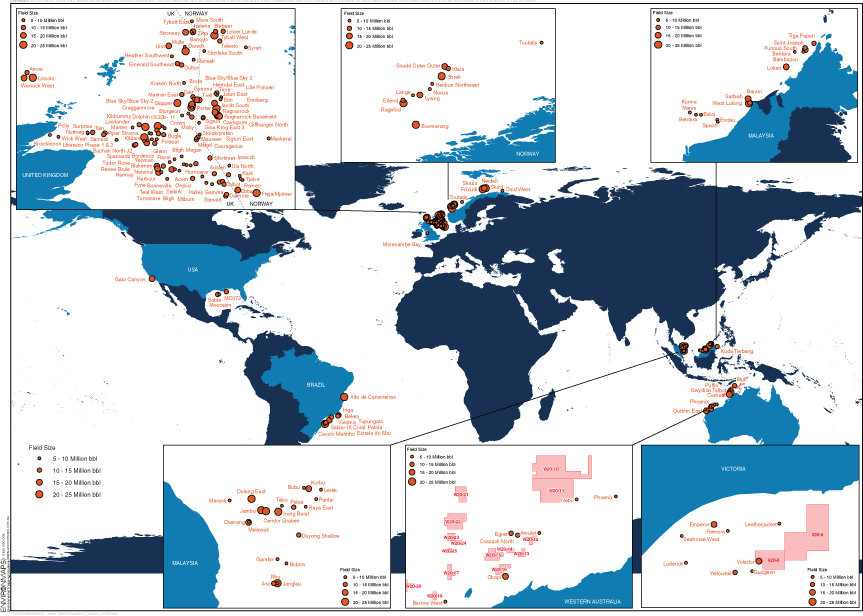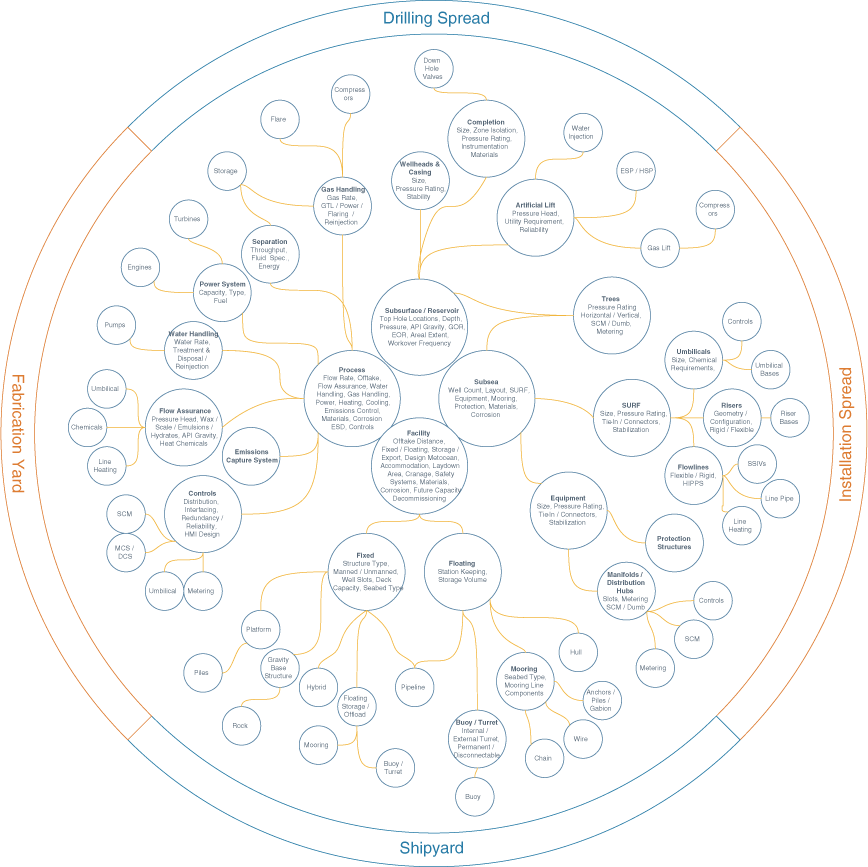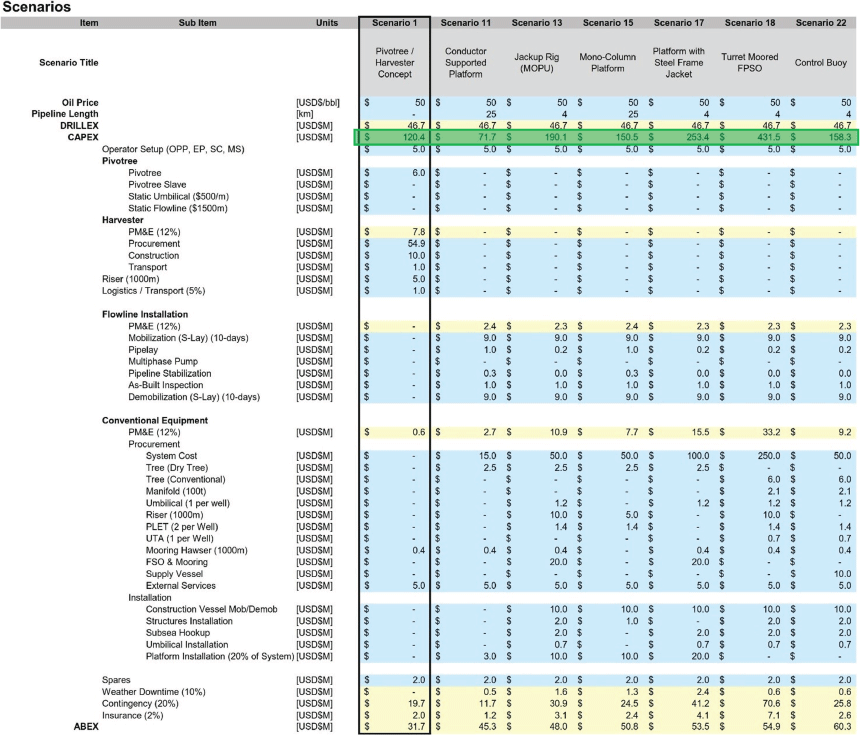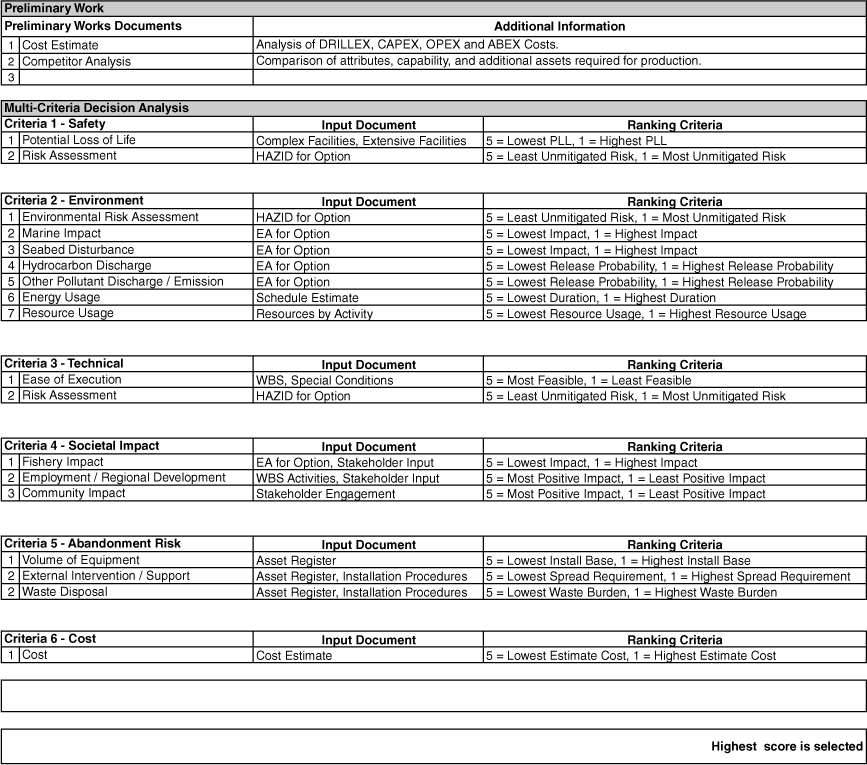Transforming offshore field developments with Pivotree™: an innovative technology solution for fast, cost effective, and low footprint projects
Christopher Merrick A *A

Chris Merrick has over 20 years of experience in subsea engineering, project management, operations, asset integrity, and inspection maintenance and repair. He has experience across the entire lifecycle of offshore developments encompassing engineering, procurement, construction, installation, operations, and decommissioning. He is a specialist in subsea equipment technical reliability, ensuring that facilities meet the highest standards of safety, compliance, and production availability. Pivotree™ is Chris’ idea, conceived to bring more projects for more operators into production, efficiently, safely, and profitably. Chris has a Bachelor’s Degree in Computer Science, a Master’s Degree in Oil and Gas Engineering, and a Masters of Business Administration from the University of Western Australia, is a Chartered Subsea Engineer, and Fellow of Engineers Australia. |
Abstract
Pivotree™ represents a technology paradigm shift in offshore oil field development, reducing cost and providing a route to market for the operators of stranded resources. Conventional standalone projects, characterised by substantial upfront capital expenditures with complex equipment and high installation costs, are juxtaposed against the Pivotree™ solution, with a markedly reduced capital outlay that retains all the requisite safety and operational features associated with larger systems. A comparative study of activities, materials, and risks concomitant with different field development concepts are analysed for a range of reservoir characteristics, highlighting the financial advantages of the Pivotree™ technology using Multiple-Criteria Decision Analysis (MCDA). MCDA allows a systematic assessment and comparison of a broad spectrum of qualitative factors including safety, environmental impact, operability, maintainability, time to deploy, water depth, independence, and abandonment burden and development of a set of economic scenarios with the costs of different development concepts compared over the lifecycle phases from Drilling to Abandonment, and the Net Present Value (NPV) and Internal Rate of Return (IRR) calculated against a range of oil prices, and operating expenditures. A case study ‘Concept Select’ activity is performed using MCDA to evaluate the range of development options against the listed set of project and technology attributes. A set of weightings is provided for the purpose of analysis by the author equating to the corporate values and strategy of a fictional energy company. The MCDA analysis demonstrates that the Pivotree™ technology can unlock production from the global store of stranded offshore discovered resources.
Keywords: concept select, economically stranded, field development, floating offshore production systems, FPSO, low CAPEX, low-cost, marginal fields, mid-water, mooring, single-point mooring, stranded fields, stranded resources, subsea tree, subsea well.
Introduction
Oil and gas exploration and production activities account for approximately 5.3% of global gross domestic product (GDP) (The World Bank 2022; IBISWorld 2023), with the United States alone employing an estimated 2.3 million people directly, and five times that number indirectly (PwC 2023). The transition to renewables is behind schedule (AFR 2023; IEA 2023) and underfunded to the tune of US$2.5 trillion per year to 2050 (ETC 2023) meaning that there will be a greater reliance on hydrocarbons, particularly natural gas, for longer than envisaged by aggressive decarbonisation scenarios (IEA 2021; BP 2023).
The energy industry has focussed on exploiting the largest (25 M barrels to 50 B barrels), most economically produced (onshore and shallow water) oil fields. Few easily extracted large hydrocarbon accumulations remain, however, many discoveries deemed sub-economic at the time of discovery remain. These discovered resource opportunities, spread around the globe, range from 1 million barrels to as much as 25 million barrels (Fig. 1).
Global map of stranded fields, less than 25 MMbbls, more than 20 km from a host facility (Source: Rystad Dataset).

The Pivotree™ development concept represents a technology paradigm shift in offshore oil field development, materially reducing development costs and providing a route to market for the owners of stranded resources.
Conventional oil and gas field development
An oil and gas development is conducted over several discrete phases, segmented as short duration, high capital expenditure (CAPEX) activities followed by long duration, revenue generative operations, before decommissioning and abandonment. In Australia, the shortest path timeline from being awarded title to an offshore area into exploration, making a discovery and being able to produce (including regulatory approvals) is estimated as 5 years (i.e. ‘Explore’ to ‘Operate’ in Fig. 2).
Decision making occurs over the entire lifecycle of the field, although the largest number of decisions with the largest impacts on project success, happen during Concept Select or ‘Select’ phase: a relatively short but intense period of the development. During Concept Select the attributes (unique characteristics) of the field are assessed and the solution space for developing the field – the feasible alternatives – is established. Certain attributes (API Gravity, Assay, Pressure, Temperature, Gas–Oil Ratio (GOR), etc.) will automatically exclude certain layouts, facilities, or equipment from being used, or require the use of certain other equipment or chemicals to allow production. A desirable outcome of the activity is several feasible development ‘Concepts’ that can be compared for schedule, risk, and cost.
Fig. 3 illustrates graphically the plausible decisions emanating from the reservoir and fluid attributes, and the basic facility and process attributes selected by the operator. Each attribute defined or decision made at a higher level (close to the centre of the graph) has a knock-on effect on the equipment or components that can be selected at a lower level (close to the edge of the graph). Ultimately the sum of all decisions affects the choice of which drilling spread, fabrication yard, shipyard, and installation spread can deliver a production-ready field. An example of a field attribute that reduces feasible alternatives is the water depth. For a field that is in 500 m of water the option to select a fixed platform with a piled steel jacket is not feasible, requiring the selection of either a floating facility or subsea tie-back.
The screening process must consider the cost impact of all decisions, as while there may be many technically feasible options if all concepts carry too high a cost against the revenue potential, then the projects cannot be executed in the forecast oil-price environment or with current technology and are economically stranded.
Field development concepts
There are many feasible concepts, of either open or proprietary design, that can be built to exploit a field, though all can be fit into a few generalised categories:
fixed: a permanently installed facility that is attached to the seabed,
floating: a permanently moored or disconnectable floating facility; or,
subsea tie-back: a subsea well, flowline and umbilical connecting a remote reservoir to another fixed or floating facility.
The varying specifications of the concepts listed in Table 1 are due to the technical innovations that overcome specific problems with the fields discovered in that era – largely due to exploration moving into much deeper water and that discoveries contained fluids that were heavy, viscous, high pressure, high temperature, and/or corrosive.
| Fixed | Floating | Subsea tie-back | |
|---|---|---|---|
| Platform with steel frame jacket | Ship shaped FPSO with mooring | XTs with flowline/umbilical | |
| Gravity base structure | Sevan shaped FPSO with mooring | XTs with flowline/control buoy | |
| Mono-column platform | FPSO with dynamic positioning | XTs with flowline/subsea tanks | |
| Conductor supported platform | Production barge with mooring | XTs with flowline/subsea boosting | |
| Jackup rig (MOPU) | Spar/cell spar platform | ||
| Compliant tower platform | Semi-submersible (MOPU) | ||
| Tension leg platform | Control buoy | ||
| Drillship (converted to MOPU) |
MOPU, mobile offshore production unit; FPSO, floating production storage and offtake; XTs, xmas trees
As detailed above, the selection of one or other facility type is predicated on the requirements of the field and the fluids to be produced. The selection of one facility type is a trade-off of the attributes of one concept against another to determine the most optimal technical solution. Optimal in the case of facility selection may mean the highest reliability and availability of the production system, the easiest to operate or most flexible process equipment, the highest flowrate capacity, or the most future proof or upgradeable spread that can be installed. The definition of ‘optimal’ is established by the operator of the field during Concept Select and integrates a mix of both qualitative and quantitative metrics to allow comparison of the feasible concepts (Table 2).
| Facility type | Well count | Trees | Mobile | Storage | Water depth (m) | Station keeping | Production export | |
|---|---|---|---|---|---|---|---|---|
| Platform with steel frame jacket | Multiple | Dry | No | No | 500 | Piles | Pipeline | |
| Gravity base structure | Multiple | Dry | No | Yes | 300 | Mass | Shuttle tanker | |
| Mono-column platform | Multiple | Dry | No | No | 70 | Piles | Pipeline | |
| Conductor supported platform | 3 or 4 | Dry | No | No | 70 | Wells | Pipeline | |
| Jackup rig (MOPU) | Multiple | Dry | Yes | No | 110 | Legs | FSO | |
| Compliant tower platform | Multiple | Dry | No | No | 500 | Piles | Pipeline | |
| Tension leg platform | Multiple | Dry | No | No | >1000 | Tendons | Pipeline | |
| FPSO with mooring | Multiple | Wet | Yes | Yes | >1000 | Anchors | Shuttle tanker | |
| FPSO with dynamic positioning | Multiple | Wet | Yes | Yes | >1000 | DP | Shuttle tanker | |
| Production barge with mooring | Multiple | Wet | Yes | No | 50 | Anchors | FSO | |
| Spar/cell spar platform | Multiple | Wet | No | Yes | >1000 | Tendons | Shuttle tanker | |
| Semi-submersible (MOPU) | Multiple | Wet | No | No | >1000 | Anchors | Shuttle tanker | |
| Control buoy | Multiple | Wet | No | No | >1000 | Tendons | Pipeline | |
| Drillship (converted to MOPU) | Multiple | Wet | Yes | Yes | >1000 | Anchors | Shuttle tanker | |
| XTs with flowline/umbilical | Multiple | Wet | No | No | >1000 | Well | Flowline | |
| XTs with flowline/control buoy | Multiple | Wet | No | No | >1000 | Well | Flowline | |
| XTs with flowline/tanks | Multiple | Wet | No | No | >1000 | Well | Flowline | |
| XTs with flowline/boosting | Multiple | Wet | No | No | >1000 | Well | Flowline |
Where an attribute is assigned to a facility type, the most commonly deployed option is listed in the table. DP, dynamic positioning; FSO, floating storage and offtake.
The Pivotree™ development concept
Pivotree has designed a floating, field development concept for predominantly liquids-based hydrocarbon reservoirs that are too small to support a standalone development, but too far from existing facilities to tie back or in water too deep for a low-cost fixed platform.
The development concept comprises two elements:
The Pivotree™: a modified subsea Xmas Tree (XT) provides the pressure containing, flow control system for the well and hosts the flexible riser and swivel assembly mounted to the upper tree block mandrel with a wellhead connector. Below the XT, the Mooring Permanent Guide Base (MPGB) is welded to the surface casing, providing a 360° weathervaning mooring for a small FPSO called the Harvester. Importantly, the MPGB has a high mooring load capacity being designed with a 100 t Safe Working Load (Factor of Safety = 2.0). This is the equivalent load generated by a 50,000-deadweight tonne (DWT) vessel in a 100-year return period storm offshore, North West Shelf (NWS), Western Australia.
The Harvester FPSO: supporting surface separation and processing facilities that are modularised components as would be used in any floating offshore production facility. The Harvester FPSO will integrate a remotely operated vehicle (ROV), and crane(s) sized to allow for recovery of the replaceable sub-components on the Pivotree™.
Selecting the Pivotree™ concept means that the Installation phase of the lifecycle is eliminated: once the well is drilled and completed, the Harvester FPSO can self-install the flexible riser and swivel assembly upon entering the field, and no additional equipment or construction spreads are required to start production (Table 3).
| Facility Type | Well count | Trees | Mobile | Storage | Water depth (m) | Station keeping | Production export | |
|---|---|---|---|---|---|---|---|---|
| Pivotree™/Harvester FPSO | 2A | Wet | Yes | Yes | 500 | Single point mooring | Shuttle tanker |
Gas and water handling are key decisions to be made during Concept Select that when improperly sized can bring a premature end to production. All safety and safeguarding systems will be built into the design in accordance with the requirements of the regulations and applicable codes and standards.
Anticipating that both zero flaring of associated gas, and emissions control will become key requirements of new field developments in many jurisdictions, the Harvester FPSO process will be designed to integrate process equipment to meet both requirements. For emissions control integration of a flue gas capture system (MMKMC 2022; Axens 2023; Value Maritime 2023; Wartsila 2023) to capture engine and process emissions will be integrated into the redeployment scope of the Harvester FPSOs base vessel. Associated gas produced with the well fluids will be utilised primarily for fuel.
Through the design process of the Pivotree™ choices have been made to minimise the CAPEX required to produce a single well, that precludes other options from being implemented. The Pivotree system will not be suitable for all combinations of reservoir, flowrate, or well fluids but has been designed with sufficient flexibility for broad applicability.
Capital and abandonment expenditure (ABEX) cost savings
In the Construct phase, the scope of supply of the Pivotree™ concept is significantly reduced with a knock-on effect reducing CAPEX and schedule. The base case for the Harvester FPSO is a redeployment of existing tanker tonnage and the use of a Single Point Mooring (SPM) using the ship’s existing bow equipment means that there is no lengthy shipyard scope for structural modifications of the hull to accommodate either an internal or external turret. The shipyard scope is reduced to the repair, rectification or replacement of marine, power, and utility systems, and the integration of the comparatively small process topsides. In terms of comparison with other development concepts, only the minimum facilities platforms compare in CAPEX terms (Fig. 4), noting that their water depth and weather limitations restrict their applicability.
The installation phase demands intricate planning and logistics to transport, install, and connect the various subcomponents. This process is resource-intensive and a significant contributor to the CAPEX required for conventional developments. In contrast, Pivotree™ is a single subsea structure, installed by the drilling spread when the well is completed, obviating the need for a separate installation spread and reducing the time to first oil. Any concept requiring activity in the installation phase is automatically more expensive than a Pivotree™ solution.
Pivotree™ is peerless in terms of abandonment liability, because once the well is plugged and abandoned (P&A), and the surface casing is cut and recovered, there is nothing left on the seabed. There are no other elements of the production system to be decommissioned and the Harvester FPSO and Pivotree™ XT can be reused. The system is designed to be reusable over multiple oil fields, supporting a 15-year design life. Specific design elements have been included to facilitate retrieval and redeployment ensuring that full value is captured from the equipment’s economic life and reducing the need for new equipment. For the case of a conventional subsea tie-back, while the XT may be reused elsewhere, it is uneconomical to recover and relay pipe and umbilicals requiring abandonment of these items.
Multi-criteria decision analysis
Multi-Criteria Decision Analysis (MCDA) is a structured decision-making tool that allows comparative analysis of several options according to their attributes with rankings against weighted decision criteria. Paraphrasing Zionts, ‘In almost every decision, there are several conflicting objectives’ and ‘we make trade-offs among conflicting objectives’ to select an option ranked ‘in some sense optimal or best’ (Zionts 1979). Although taking many forms (Bell et al. 1977; Saaty 1987; Keeney and Raiffa 1993) the construction of an MCDA worksheet provides a uniform comparison between alternatives and removes individual bias because the relative importance of decision criteria is defined in advance of the attribute ranking activity. The preferences of the decision maker are integrated into the ranking process with the application of weightings to criteria, where the weightings can be relatable back to the organisation’s strategy and goals, and/or mission, vision, and values. All weightings applicable to criteria or sub-criteria are percentages.
In the context of a Concept Select activity, MCDA is a decision support framework (Eqn 1) that allows the integration of the operator’s preferences with quantitative and qualitative metrics to rank the attributes of different development concepts and determine the ‘optimal’ solution. Vastly different project attributes including risk, time, environmental impact, tax regime, social license to operate, cost, or legal jurisdiction can be compared using this method.
Setting decision preferences by the application of weightings is a critical step in the MCDA process. Numerical weights are assigned to each criterion to reflect their relative importance (priority) in the decision. When the attributes of different options are ranked against each other, the weightings quantify the relative importance of each criterion in the overall comparison of alternatives. The summation of the weighted scores by attribute and criteria result in the overall ranking (refer to Eqn 1) for that option.
MCDA for a hypothetical marginal field development
A decision is required to evaluate a set of development concepts for an offshore field with P50 of 9 MMbbls of reserves, that is 50 km offshore, in 380 m of water, producing liquid hydrocarbons with no associated gas.
Defining an MCDA worksheet (layout shown in Fig. 5) for the assessment of options, the decision is laid out to compare the following decision criteria, shown with their weighting: Safety (20%), Environment (20%), Technical (15%), Societal Impact (15%), Abandonment Risk (20%), and Cost (10%) where the weightings of the criteria have been set by the C suite management of the organisation. Each of the major criteria has several sub-criteria for ranking purposes, each having weightings of their own. A rank (score) is assigned to all criteria and sub-criteria for the development concept based on the attributes (characteristics) of the project.
Following the definition of the ranking system a multi-discipline team would compare each sub-criteria for all options according to the defined ranking criteria. The purpose of having a multi-discipline team is to capture all perspectives concerning particular options including risk, schedule, safety, technical feasibility, and operability to justifiably score the criteria. A dedicated scribe to record the proceedings, discussion, conflicts, and consensus is a useful addition to the process.
The preliminary work documents serve as inputs for the decision-making team to understand what is proposed by each of the options, and the scope of each solution. During the workshop, the options are each considered against each other, line-by-line, and a score assigned to each option for each sub-criterion. Certain options have attributes that make them inherently unfeasible, resulting in a low score for that sub-criterion. Critical sub-criteria with a heavy weighting have a larger effect on the score for the option.
By way of example, taking the Sub-Criteria ‘Ease of Execution’ the merits and shortcomings of the different options considered by the decision makers were discussed with the perspectives shown in Table 4.
| Option | Constructability | Availability of construction spreads | Volume of equipment to be installed | Suitable for water depth | |
|---|---|---|---|---|---|
| Pivotree™ system | Installed with well | Drilling rig | None | Yes | |
| Conductor supported platform | Simple, commonly used methods | Construction vessel | Small | No | |
| Jackup rig (MOPU) | Simple, commonly used methods | Construction vessel, SURF vessel | Medium | No | |
| Mono-column platform | Simple, commonly used methods | Construction vessel, crane vessel, barge | Small | No | |
| Platform with jacket | Complex but well-known methods | Construction vessel, crane vessel, barge | Large | Yes | |
| Turret moored FPSO | Complex but well-known methods | Construction vessel, towing support | Large | Yes | |
| Control buoy | Simple, commonly used methods | Construction vessel | Small | Yes |
In Table 4, the small platform options are unfeasible due to their depth limitations, the larger facilities all have significant track records of installation, and there are construction spreads available to build all options. The scope of equipment to be installed is well understood for all options. Capital cost and installation cost are not assessed as part of the ranking of this sub-criterion as it is considered elsewhere in the decision process.
Referring to the completed worksheet shown in Fig. 6, both the conductor supported platform option and the control buoy option had relatively close scores to the Pivotree™ option however feasibility reduced the score for the conductor supported platform, and the assessment of the control buoy option was generally ranked lower across all criteria except safety (the control buoy is unmanned).
Summary
Against the backdrop of a global energy landscape undergoing significant changes, characterised by a growing need for hydrocarbons and the transition to renewables, the Pivotree™ concept can provide a route to market for the global pool of stranded discovered resource opportunities.
Pivotree™ is a flexible development concept that suits a wide range of field attributes and supports high mooring loads to combat storm conditions in the offshore environment. The Harvester FPSO is disconnectable from the Mooring Permanent Guide Base and is self-supporting, needing no additional vessels to assist with mooring or disconnection, or to perform intervention work on the Pivotree™.
Selection of the most suitable (optimal) concept is a trade-off of a multitude of field attributes, including reservoir characteristics, location particulars, technical requirements, and flow assurance. An illustrative MCDA exercise was completed for an example field that underscores the suitability of the system.
This paper underscores the transformative impact of the Pivotree™ concept as a low-cost, small footprint, high reliability, and safe option for offshore oil field developments. It offers an efficient, sustainable, and versatile solution, addressing the industry’s need for rapidly deployable facilities to unlock stranded resources in an evolving energy landscape.
Supplementary material
High-resolution versions of Figs 1 and 3 are available as supplementary material online.
Data availability
The data that support this study will be shared upon reasonable request to the corresponding author.
References
AFR (2023) Transition to renewables will be much harder than people think: Broad, Australian Financial Review. Available at https://www.afr.com/companies/energy/transition-to-renewables-will-be-much-harder-than-people-think-broad-20230221-p5cm4r [accessed 6 December 2023]
Axens (2023) CO₂ Capture | Axens. Available at https://www.axens.net/markets/carbon-capture-storage/co2-capture [accessed 8 December 2023]
BP (2023) ‘Statistical Review of World Energy.’ (BP: London, UK) Available at https://www.bp.com/en/global/corporate/energy-economics/statistical-review-of-world-energy.html
ETC (2023) ‘Financing the Transition: How to Make the Money Flow for a Net-Zero Economy.’ (Energy Transitions Commission) Available at https://www.energy-transitions.org/new-etc-report-financing-the-transition/
IBISWorld (2023) Global Oil & Gas Exploration & Production - Market Size, Industry Analysis, Trends and Forecasts (2023-2028). Available at https://www.ibisworld.com/default.aspx [accessed 6 December 2023]
IEA (2023) ‘World Energy Outlook 2023.’ (International Energy Agency) Available at https://www.iea.org/reports/world-energy-outlook-2023
MMKMC (2022) ‘The Role of Onboard Carbon Capture in Maritime Decarbonization.’ (Maersk Mc-Kinney Moller Centre) Available at https://www.zerocarbonshipping.com/publications/the-role-of-onboard-carbon-capture-in-maritime-decarbonization/ [accessed 8 December 2023]
Nandurdikar N., Wallace L. (2011) Failure to Produce: An Investigation of Deficiencies in Production Attainment, in All Days. In ‘SPE Annual Technical Conference and Exhibition’, Denver, Colorado, USA. p. SPE-145437-MS. (SPE) 10.2118/145437-MS
NautiSNP (2023) Chemical / Product Tankers For Sale, NautiSNP Ship Sale & Purchase. Available at https://www.nautisnp.com/tankers/chemical-product [accessed 7 December 2023]
NSTA (2023) ‘UKCS Decommissioning Cost and Performance Report 2023.’ (North Sea Transition Authority) Available at https://www.nstauthority.co.uk/news-publications/ukcs-decommissioning-cost-and-performance-report-2023/
Saaty R. W. (1987) The Analytic Hierarchy Process - What it is and How it is Used. Mathematical Modelling 9(3–5), 161-176.
| Crossref | Google Scholar |
S&P Global (2023) Steel Price Forecast and Steel Market Outlook, S&P Global. Available at https://www.spglobal.com/marketintelligence/en/mi/solutions/steel-forecast.html [accessed 7 December 2023]
The World Bank (2022) World GDP (Current USD$), World Bank Open Data. Available at https://data.worldbank.org [accessed 6 December 2023]
Trident Steel (2023) Carbon Steel Pipe Price List and API 5L Pipe Rates per meter. Available at https://www.tridentsteel.co.in/carbon-steel-pipe-price-list.html [accessed 7 December 2023]
Value Maritime (2023) Value Maritime - Filtration Reinvented!, Value Maritime. Available at https://valuemaritime.com/services/ [accessed 8 December 2023]
Wartsila (2023) Onboard Carbon capture and Storage, Wartsila.com. Available at https://www.wartsila.com/marine/products/exhaust-treatment/carbon-capture-and-storage [accessed 8 December 2023]
Zionts S. (1979) MCDM: If Not a Roman Numeral, then What? Interfaces 9(4), 94-101.
| Crossref | Google Scholar |
Appendix 1.Additional tables
| Cost element | Source | Cost range (US$) | Cost units | Weight (t) | Price adopted | |
|---|---|---|---|---|---|---|
| Steel price [hot rolled coil] | S&P Global (2023) | 600–800 | $/tonne | 1 | 800 | |
| Steel price [API 5L pipe] | Trident Steel (2023) | 1221–3100 | $/tonne | 1 | 1500 | |
| Structural steel (fabricated, Australia) | 2023 Project | 7359.16 | $/tonne | 1 | 7500 | |
| Smart steel (fabricated, Australia) | 2023 Project | 34,679.96 | $/tonne | 1 | 35,000 | |
| Pipe 6″ X56, XXS, 3LPP | Calculated | $/km | 0.079 | 118.50 | ||
| Umbilical | Historical A (5) | 151–750 | $/m | N/A | 301 | |
| Static flexible flowline | Historical (11) | 296–774 | $/m/inch | N/A | 478 | |
| Mooring chain | Historical (6) | 53.71–212.46 | $/m/inch | N/A | 115 | |
| Mooring anchors | Historical (3) | 2946–5200 | $/tonne | 1 | 3950 | |
| Subsea tree | Historical (5) | 3.68–9.91 M | $ | N/A | 6 M | |
| Product tanker (~50 k DWT) | Table 2 | 767–1251 M | $ | N/A | 10 M | |
| Manifold (4 slot, 100 t) | Calculated | $ | 100 | 2.1 M | ||
| Pipelay vessel (S-Lay, 3 km/day) | 2020 Project | 800 k–1 M | $/day | N/A | 900,000 | |
| Pipelay mob./demob. | Estimate 10 days | 9,000,000 | $/each | N/A | 9,000,000 | |
| Construction/flex-lay vessel | 2023 Project | 400–600 k | $/day | N/A | 500,000 | |
| Construction mob./demob. | Estimate 10 days | 5,000,000 | $/each | N/A | 5,000,000 | |
| Drilling (complete) | 2022 Well | 32 M | $/well | N/A | 32 M | |
| OPEX (Australia, offshore) | Rystad (2021) (8) | 18–24.1 | $/barrel | N/A | 21 | |
| Abandonment (UK, subsea) | NSTA (2023) | 9.43–10.05 M | $/well | N/A | 10 M | |
| Contingency | Nandurdikar and Wallace (2011) | 21% |
| Name | DWT | Year | Shipyard | Location | Price (US$) | |
|---|---|---|---|---|---|---|
| Mac Shanghai | 30,835 | 1997 | Japan | Southeast Asia | $5,250,000 | |
| Tiger | 31,158 | 2002 | Japan | Southeast Asia | $9,500,000 | |
| Dl Lavender | 35,194 | 2014 | Korea | Southeast Asia | $21,500,000 | |
| Theo | 36,200 | 1997 | Japan | Southeast Asia | $9,200,000 | |
| Giving | 45,000 | 1997 | Oshima | Persian Gulf | $7,500,000 | |
| Michalakis | 45,769 | 1998 | Japan | Far East Asia | $10,250,000 | |
| Maxine | 46,000 | 2009 | Japan | Southeast Asia | $11,500,000 | |
| U Glory | 46,570 | 1998 | Japan | Persian Gulf | $8,750,000 | |
| Rising Harrier | 47,195 | 1997 | Korea | Far East Asia | $10,000,000 | |
| Kai Xuan 11 | 50,000 | 2000 | MITSUI | Far East Asia | $7,400,000 | |
| Lofty Mountain | 51,000 | 2002 | Oshima | Far East Asia | $9,250,000 | |
| Pacific 08 | 52,471 | 2004 | Japan | Far East Asia | $11,000,000 |
 Chris Merrick has over 20 years of experience in subsea engineering, project management, operations, asset integrity, and inspection maintenance and repair. He has experience across the entire lifecycle of offshore developments encompassing engineering, procurement, construction, installation, operations, and decommissioning. He is a specialist in subsea equipment technical reliability, ensuring that facilities meet the highest standards of safety, compliance, and production availability. Pivotree™ is Chris’ idea, conceived to bring more projects for more operators into production, efficiently, safely, and profitably. Chris has a Bachelor’s Degree in Computer Science, a Master’s Degree in Oil and Gas Engineering, and a Masters of Business Administration from the University of Western Australia, is a Chartered Subsea Engineer, and Fellow of Engineers Australia. |







